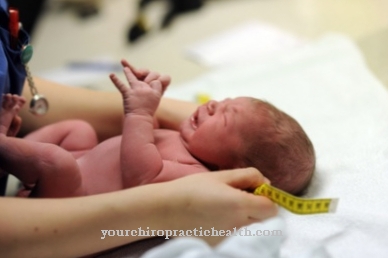Of the Dorsal reflex is a pathological self-reflex of the interossei plantares muscles and is one of the pyramidal signs. In a healthy adult, the reflex plantar flexion of the toes can hardly or not at all be triggered with a blow on the dorsal side of the foot. The triggerability indicates pyramidal lesions.
What is the dorsal reflex?

Reflexes are involuntary muscle contractions that can be triggered by certain stimuli. Most of the human reflexes are protective reflexes. There is a fundamental difference in the reflex arc. Depending on your reflex arc, reflex movements are either external reflexes or muscle self-reflexes.
In the case of an external reflex, the affector and the effector are not in the same organ. The localization of the stimulus-absorbing pathways does not correspond to the motor pathways that trigger the movement. In contrast, in the case of self-reflexes, the affector and effector are in the same organ. The reflexes are interconnected by the shortest route via the anterior horn of the spinal cord. External reflexes are subject to a polysynaptic interconnection. In contrast, self-reflexes are connected via only one synapse and are therefore also called monosynaptic.
The dorsal reflex is a reflex of the plantar interossei muscles, which can be triggered by a blow on the dorsal side of the foot. It plays a role in the neurological reflex examination and is one of the so-called pyramidal orbit signs when the response is exaggerated.
Function & task
The interossei plantares are three muscles of the short muscles of the foot. They arise from the base and medial side of the metatarsal bones. Their short tendons attach to toes III, IV and V medial to the proximal phalanges. In addition, there is an attachment to the tendon aponeuroses of the extensor digitorum longus muscle.
The interossei plantares muscles are involved in the adduction of the toes. So you can move the toes in the metatarsals and pull them towards the foot. The three foot muscles also cause flexion of the proximal phalanx and are also involved in stretching the middle and distal phalanges.
The muscle group is innervated by the lateral plantar nerve. This is a mixed nerve branch of the tibial nerve that carries motor and sensory fibers. The nerve runs together with the lateral plantar artery to the lateral side of the foot and runs between the quadratus plantae muscle and the flexor digitorum brevis muscle.
The lateral plantar nerve divides into a deep branch and a superficial branch, also known as the superficial branch and the profund branch. As a mixed nerve, the neural structure supplies the skin of the fifth toe to the lateral part of the fourth toe with sensitive nerve fibers and is also involved in the motor innervation of various foot muscles.
The interconnection of the lateral plantaris nerve takes place via the spinal cord segments S1 and S2. With the dorsal reflex, the impact on the dorsum of the foot is registered by the muscle spindles of the plantar interossei muscles. They transmit the stimulus information to the central nervous system via the afferent pathways of the lateral plantar nerve.
The information of the reflex response on the efferent tracts of the nerve runs back to the musculi interossei plantares via a synapse in the aforementioned spinal cord segments and allows the muscles to contract. This triggers a plantar flexion of the toes. So the toes bend towards the sole of the foot.
Plantar reflexes such as the dorsal reflex are usually hardly or not at all pronounced in adults. The pyramidal tracts of the spinal cord are responsible for controlling movement. They connect the central motor neurons with each other, which act as a controlling switch point for reflex and voluntary motor skills. In infants, movement control by the central motor neurons is not yet fully developed. They move muscle groups such as the interossei plantares muscles together and have far more reflexes than an adult.
Illnesses & ailments
If the neurologist detects a pronounced dorsal reflex in an adult during the reflex examination, then this observation is assessed as a so-called pyramidal trajectory sign. All reflexes of the plantar muscles are interpreted as pyramidal trajectory signs if the reflex response is pronounced.
The medical practitioner understands this to be a group of pathological reflexes that indicate pyramidal damage. Lesions in the pyramidal tracts or the pyramidal system can override the overriding control of movement by the central motor neurons and thus trigger reflex responses that cannot be triggered, or only to a limited extent, in a healthy person.
Other dorsal reflexes with pathological value are the Rossolimo reflex and the Piotrowski reflex. The Babinski group is also one of the pyramid railway signs.
As a solid indication of a pyramidal lesion, the neurologist usually only evaluates a positive dorsal reflex if there are other signs of the pyramidal trajectory and the patient's clinical picture matches a pyramidal tract lesion. Such a lesion can, for example, cause spastic ataxia and thereby alter or cancel the muscle tone. Muscle weaknesses or paralysis are also conceivable in the context of pyramidal lesions.
The symptoms depend on the exact location of the lesion. The localization can also provide clues as to the primary cause of the central nervous damage. Therefore, the localization is usually determined more precisely using imaging methods such as MRI.
If the pyramidal parts of the brain are affected, head trauma or a stroke may be the cause. If, on the other hand, the spinal cord itself is affected, these two relationships are excluded. A neurological disease, a spinal cord infarction or traumatic spinal cord damage are conceivable causes.
As neurological diseases, for example, multiple sclerosis or ALS can damage the motor pathways of the spinal cord. Both in the brain and in the spine, space claims are also conceivable as triggers for the pyramidal orbit signs.



























